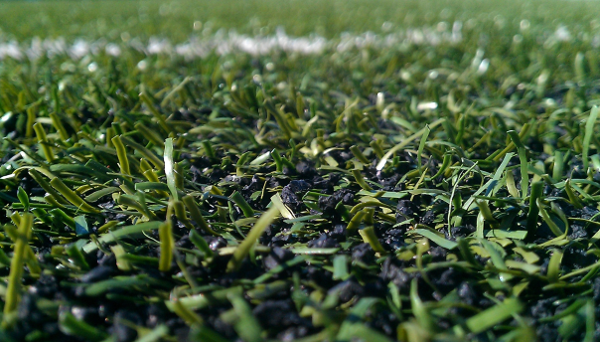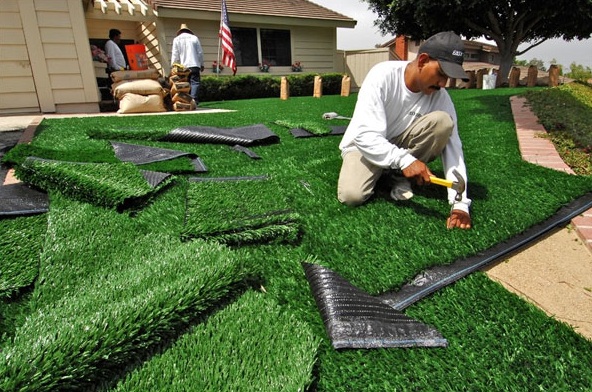Explore the Environmental Advantages of Opting for Artificial Grass Solutions
The adoption of man-made grass remedies offers an engaging possibility to deal with pushing ecological difficulties. By substantially lowering water use and reducing the application of harmful chemicals, these alternatives not just promote sustainable landscaping however likewise protect local environments. In addition, the reduced carbon footprint linked with lowered maintenance tasks adds to an extra sustainable strategy to land administration. The implications of these advantages prolong beyond simple conservation efforts, increasing concerns regarding their long-lasting impact on environment conservation and general eco-friendly equilibrium. Exploring these measurements discloses a complicated interplay worth taking into consideration.
Water Preservation Conveniences
Among one of the most considerable benefits of fabricated lawn is its ability to preserve water. Typical grass yards need considerable watering, particularly in locations prone to drought or water limitations. On the other hand, synthetic grass does not need watering, considerably reducing the total demand for water sources. This feature is especially beneficial in dry areas where water scarcity is a pressing problem.
By removing the demand for routine watering, artificial turf contributes to sustainable landscape practices and aids alleviate the environmental influence of excessive water intake. The conservation of water extends to the decrease of drainage, which can lead to dirt disintegration and waterway pollution.
In addition, the setup of artificial lawn enables home owners and towns to allot water sources much more successfully, concentrating on crucial uses such as drinking water and agriculture. The change towards synthetic grass not just advertises liable water use however additionally aligns with more comprehensive ecological objectives aimed at protecting natural deposits.
As communities progressively prioritize sustainability, the water conservation benefits of synthetic grass present a compelling case for its fostering in commercial and property landscaping projects.
Reduced Chemical Usage
The change to synthetic turf significantly decreases the reliance on chemical therapies generally made use of in natural turf maintenance. Typical turf administration usually includes the application of herbicides, fertilizers, and pesticides to promote growth and control insects. These chemicals can position dangers to human wellness, regional wildlife, and the setting, contributing to dirt and water contamination.
In comparison, fabricated grass eliminates the need for these harmful compounds. By lessening the release of synthetic compounds into the ecosystem, synthetic lawn advertises much healthier soil and water systems.
Additionally, the lack of chemical runoff related to synthetic grass installments helps secure local waterways from contamination, sustaining aquatic life and keeping biodiversity. Turf installation phoenix az. As neighborhoods significantly focus on sustainable practices, opting for synthetic grass offers a sensible option that lines up with ecological conservation goals. Through this change, homeowner can take pleasure in lush green rooms without compromising eco-friendly health, leading the way for a much more lasting future
Lower Carbon Impact

In addition, the installation of synthetic grass can result in significant water conservation. Natural yards need substantial amounts of water for irrigation, which not only contributes to the carbon impact related to water extraction and therapy however also strains neighborhood water resources. In contrast, synthetic grass needs minimal upkeep, needing no watering, Artificial turf companies phoenix thus dramatically minimizing water use and its associated energy costs.
Furthermore, the long life of synthetic grass adds to its lower carbon impact. With a lifespan of up to 15 years or even more, the requirement for frequent substitutes is reduced, resulting in much less waste and reduced energy intake in manufacturing and taking care of standard yard options. Generally, artificial turf provides a lasting choice for ecologically conscious landscaping.
Environment Preservation
Environment preservation is an essential consideration in the discussion over landscape design options, especially when contrasting synthetic grass to natural turf. Natural yard yards commonly need extensive upkeep, consisting of using pesticides, plant foods, and herbicides, which can detrimentally impact over here neighborhood ecosystems. These chemicals can leach into the dirt and rivers, harming native flora and animals and interrupting local habitats.
Artificial turf gets rid of the requirement for damaging chemicals, thereby shielding close-by wildlife and keeping the stability of surrounding environments. The installment of artificial grass can lead to the conversion of former grass locations into more biodiverse landscapes, such as pollinator gardens or indigenous plant locations, which can sustain local wildlife.
Inevitably, the transition to fabricated lawn not only saves water and reduces maintenance initiatives however also cultivates a more harmonious partnership between human tasks and the all-natural setting, advertising environment preservation in the process.
Long-Term Sustainability
Long-lasting sustainability is a critical consider reviewing the benefits of man-made turf over typical turf yards. Among the most significant advantages of artificial turf is its longevity; it can last up to 15-20 years with minimal maintenance, whereas natural lawn requires constant reseeding and substitute. This durability decreases the requirement for constant sources, such as water, plant foods, and chemicals, which are vital for preserving a healthy and balanced turf yard.
In addition, synthetic turf contributes to a reduction in carbon discharges related to lawn treatment devices. Standard yards usually require gas-powered lawn mowers, trimmers, and blowers, all of which add to air contamination. Artificial turf companies phoenix. On the other hand, synthetic grass eliminates the demand for such devices, promoting Full Report a cleaner environment
In addition, the manufacturing of synthetic grass increasingly utilizes recycled products, boosting its sustainability account. As suppliers embrace green practices, the ecological impact of synthetic grass remains to reduce.

Conclusion
The fostering of fabricated grass solutions provides considerable environmental advantages, including considerable water preservation, decreased reliance on hazardous chemicals, and a lower carbon impact. Fabricated grass aids in maintaining all-natural habitats by reducing land disruption and advertising lasting sustainability via the use of durable products. Collectively, these elements emphasize the potential of synthetic grass to contribute positively to environmental health and wellness and provide a feasible choice to typical landscape design practices in a progressively resource-conscious globe.
In comparison, fabricated grass does not need watering, substantially reducing the overall need for water resources. By reducing the release of synthetic substances right into the community, artificial turf promotes healthier dirt and water systems.
Additionally, the installation of synthetic lawn can result in substantial water conservation. In contrast, fabricated turf needs minimal upkeep, calling for no watering, thereby considerably decreasing water use and its associated power expenses.
